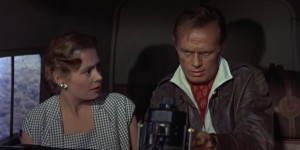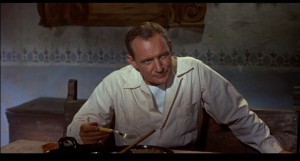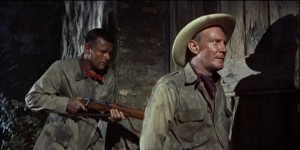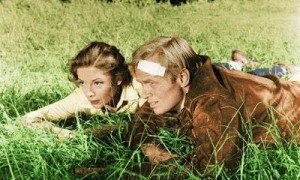One morning, Mike finds her luggage piled in the taxi that brought her. Fernandez (Juan García) is going to drive her to Acapulco, to catch a plane for Mexico City. “In that box of bolts?” Mike jokes. In one of the film’s humorous moments, Mike asks Fernandez how many times he’s started out for Acapulco. Seven, he says. And how was Acapulco? He doesn’t know: he’s never gotten there. Mike offers to fly Katie to Mexico City in his plane.
Before they take off, Katie removes from her seat Mike’s revolver and places it on the plane’s dash next to the compass. Mike puts it behind his seat. “Not next to the compass, Katie,” he says. Whereupon she places her purse—that’s right!—on the dash next to the compass, and because of that magnetic note pad inside—remember?—the compass makes a quarter turn! You can guess what’s coming.
 Sure enough. After flying above the clouds for sometime, Mike figures Mexico City lies directly ahead, and descends. Oops! No Mexico City. Jungle! About this time, they run out of gas and have to make a forced landing—in a convenient clearing. But the plane crashes and Mike receives a concussion.
Sure enough. After flying above the clouds for sometime, Mike figures Mexico City lies directly ahead, and descends. Oops! No Mexico City. Jungle! About this time, they run out of gas and have to make a forced landing—in a convenient clearing. But the plane crashes and Mike receives a concussion.
They are rescued by Browne and Van Anders and taken to their rambling—and isolated—hacienda, complete with a wandering, rifle-bearing sentry, a pack of Dobermans—the “hounds of the Baskervilles,” as Mike calls them—and wary Mexican natives who have tied up a lion. Browne confirms that, indeed, they are isolated, with no means of communication with the outside world.
The two house guests soon become suspicious. Van Anders claims to be an archeologist studying a pre-Mayan civilization in the area. Mike comments that he didn’t know there were any known civilizations before the Mayans. Also, Katie discovers there are no archeology books in the library. There is, however, a book by Nietzsche—in the original German. Mike’s revolver has disappeared from his bag. And he senses he has met Browne before—and his voice is beginning to sound awfully familiar.
Later, hearing him speak  without seeing him, Mike recalls where he’s heard the voice, and under what circumstances. Under the pretext of a plot for another book—now he’s broken his writer’s block!—he outlines Browne’s personal history in great detail— Richard Widmark’s best moment in the film—and suggests he make a bargain with Browne. That proves a mistake: Mike’s taken too much for granted, and there’s an unanticipated event in the Browne’s biography!
without seeing him, Mike recalls where he’s heard the voice, and under what circumstances. Under the pretext of a plot for another book—now he’s broken his writer’s block!—he outlines Browne’s personal history in great detail— Richard Widmark’s best moment in the film—and suggests he make a bargain with Browne. That proves a mistake: Mike’s taken too much for granted, and there’s an unanticipated event in the Browne’s biography!
Mike and Katie’s only hope now is escape, and eluding their pursuers picks up the substance of the original story of The Most Dangerous Game—the foregoing having comprised excellent changes and additions. Neither the story nor the viewer is let down by the thirty-five minute chase through the jungle and back again, to the hacienda—much more detailed and exciting than in the 1932 flick.
 There is the trek through the jungle, with its swamps, streams, wild boars and, of course, always, the armed hunters, with the counterpoint sounds of their Dobermans. Night respites, snakes, sleep deprivation, the heat, barking dogs. Tired and almost frantic at one point, Katie is ready to give up, for Mike to go ahead on his own. But the two are reconciled when, earlier, her true identity had been revealed in a radio broadcast. Mike sets booby traps and makes a bow and arrow from branches and vines and fights a Doberman. And, remember, while he may have no rifle, though a native gives him a machete, he does have that single bullet!
There is the trek through the jungle, with its swamps, streams, wild boars and, of course, always, the armed hunters, with the counterpoint sounds of their Dobermans. Night respites, snakes, sleep deprivation, the heat, barking dogs. Tired and almost frantic at one point, Katie is ready to give up, for Mike to go ahead on his own. But the two are reconciled when, earlier, her true identity had been revealed in a radio broadcast. Mike sets booby traps and makes a bow and arrow from branches and vines and fights a Doberman. And, remember, while he may have no rifle, though a native gives him a machete, he does have that single bullet!
The music of Fred Steiner is little more than adequate. The main title is something of a jumble of weak ideas and little development, an uncertain cross, perhaps, between attempts at a jungle milieu and some possible Mexican idiom. It’s hard to know. I’m reminded of Daniele Amfitheatrof’s stark, ear-catching main title for a somewhat similar film two years earlier, The Naked Jungle with Charlton Heston and Eleanor Parker.
 At one point during the escape, as Katie and Mike wade into a stream, Steiner introduces a four-note motif that is quite appropriate—nervous, intense and, at the same time, ominous. Too similar to be coincidental, the music is lifted from the opening of Zoltán Kodaly’s Dances of Galánta. This sudden “originality” is in stark contrast with the rest of the score.
At one point during the escape, as Katie and Mike wade into a stream, Steiner introduces a four-note motif that is quite appropriate—nervous, intense and, at the same time, ominous. Too similar to be coincidental, the music is lifted from the opening of Zoltán Kodaly’s Dances of Galánta. This sudden “originality” is in stark contrast with the rest of the score.
Humor, as I said, is scattered throughout the film, especially in the beginning when the lady magazine writer arrives at the shabby San Marcos airport, more a field. The portrayal of Fernandez, the taxi driver, as a lazy Mexican would, today, be deemed ethnically improper. Already reluctant to drive Katie Connors to town, he sees her luggage, two large suitcases and two small ones. “They look heavy,” he observes and takes the two small ones. As they rattle along in the topless Model-T, she asks if there are any Americans in town. Fernandez says, sure, there’s Señor Miguel. All he does is “fish, fly his plane, shoot and read. But he never works. He’s a very good friend of mine.”
Katie instantly quips, “I can believe that.”
How can I purchase this 1946 richard widmark movie?
Why purchase, when it’s easily available on youtube.com or ok.ru
https://www.youtube.com/watch?v=l_l2EHN_un0
Interestingly, but sadly, it seems Jane Greer caught some virus while location filming which culminated in a heart operation.